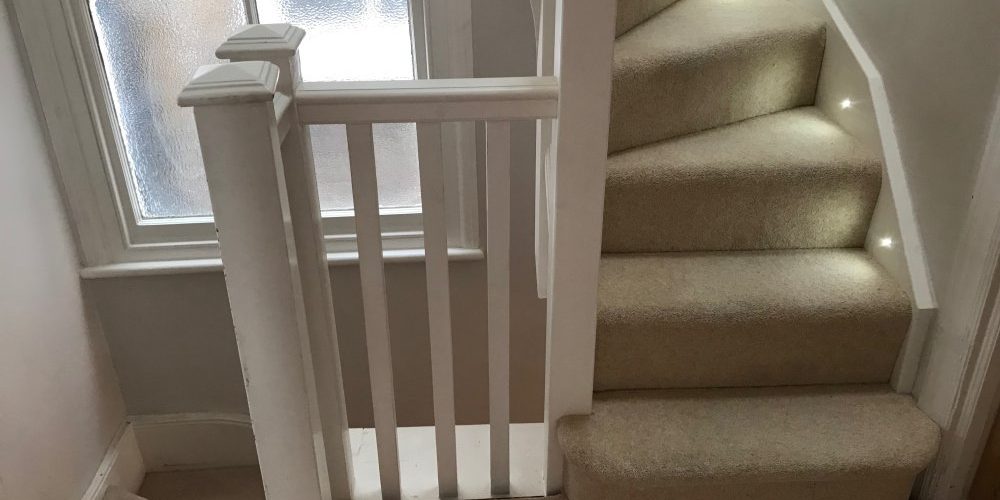Can you do a loft conversion with a small landing?
Welcome to our exploration of small loft conversion stairs, a clever solution for adding space and value to your home. In the UK, where space is often at a premium, homeowners frequently face the challenge of a small landing. But does this mean you have to forgo your dream of a loft conversion?
Absolutely not!
In this guide, we’ll delve into how you can achieve a stunning loft conversion even with a small landing, showcasing the art of space maximisation and intelligent design. Many customers that have a small landing worry that they will not be able to convert their loft for fear that their landing is not big enough to house a staircase. Rest assured, there are many options we can consider in homes with a small amount of landing floor space, in order to find the most convenient and practical position for the loft conversion stairs and execute a successful loft conversion that satisfies both your needs as well as those stated by building control.
Loft staircase building regulations
Adding any kind of structure to your home requires you to meet strict building control regulations. As experts in the field, we will be able to walk you through everything you need to know if you choose us for your loft conversion project. We also have a very experienced structural engineer on hand to offer bespoke advice, whatever your situation may be.
Here are some of the basic regulations that your loft staircase will be required to meet:
- The maximum pitch of the stairs is 42 degrees.
- There must be at least 1.9m of headroom at the centre of the flight.
- There must be at least 1.8m of headroom at the edge of the stairs.
- The vertical surface of the stair (risers) must be of equal level.
- There is no minimum staircase width but anything less than 600mm is likely to be unpractical. Plus, if stairs have a drop of more than 650mm – a handrail is required.
- Landing areas need to be a minimum size before the staircase and at the top of the stairs.
- Vertical spindles should boast a 99mm gap between them.
- Your staircase will also need to meet fire safety regulations which will include having a suitable fire door at the top or the bottom of the stairs (the loft stairs).
Designing a loft staircase for small landing spaces
Loft conversions in UK homes with small landings bring a distinct set of challenges, particularly regarding design practicality and space optimisation. Crafting a staircase that fits these compact spaces and harmonises with the existing home layout and style requires careful consideration. While small landings can make the task more complex, it’s a manageable obstacle. Our expertise, honed over thirty years, allows us to navigate these limitations creatively, often finding solutions that avoid sacrificing essential living spaces. We strive to blend functionality with design elegance, ensuring the new loft conversion stairs for small landings complement your home seamlessly.
Innovative compact stairs loft conversion
Are you embarking on a loft conversion with a small landing? The staircase you choose is crucial, not just for practicality but also for injecting style into your home. In the realm of compact spaces, creative stair solutions are essential. Let’s explore some of the most ingenious and space-efficient stair options that blend functionality with flair, all while meeting UK safety standards.
- Paddle stairs: Ideal for the tightest spots, paddle stairs (also known as space-saver stairs) offer a compact footprint. Their unique paddle-shaped treads allow for a steeper ascent without compromising on safety or comfort.
- Alternating tread stairs: These are a smart pick for small landings. With alternating treads, they provide a safe and comfortable climb in a condensed space. Each step is designed to maximise foot space, ensuring a secure footing.
- Bespoke spiral staircases: Spiral stairs are not just space savers but a statement piece. Custom-designed to fit your specific space and style, they add a touch of elegance and can become the centrepiece of your home.
- Retractable stairs: Retractable stairs are an innovative option for the ultimate in space-saving. They can be folded away when not in use, freeing up valuable floor space.
- Loft ladders: When traditional staircases are not feasible, loft ladders come to the rescue. They are practical, easy to install, and can be a temporary or permanent solution, depending on your needs.
- Space saving loft conversion stairs: A versatile staircase solution that can adapt to various layouts, including straight flights or turns. It combines space efficiency with durable beech treads, ideal for frequent use.
- Mini space saving stair kit: This compact, contemporary staircase features an alternative tread design for climbing heights in limited spaces. It includes a handrail for safety, offering a stylish and practical solution for small areas.
In addition to these options, it’s essential to consider the headroom height available for your loft stairs. Tailoring a solution that maximises headroom can significantly enhance the comfort and functionality of your loft conversion.
At Touchstone Lofts, we’re committed to finding the right staircase solution for your small landing loft conversion. With our expertise, your dream loft conversion is just a step away!
Optimising headroom in loft staircases for small landings
- Meeting UK standards: In the UK, the standard minimum headroom for loft stairs is around 2 meters. While this is a regulatory requirement, it doesn’t mean sacrificing style or comfort.
- Creative design solutions: To make the most of this space, especially in tight landings, innovative design approaches are crucial. Options include:
- Angled stairs: These can provide more headroom while fitting neatly into limited spaces.
- Partially recessed stairs: A clever solution that allows for comfortable head clearance without encroaching too much into the living space.
- Tailored to your home: Each solution is crafted to align with your home’s unique dimensions and aesthetics, ensuring functionality without compromising on design.
Integrating these elements, combined with our expertise in loft conversions, ensures that every square inch of your space is used efficiently and stylishly. For more ideas and bespoke solutions, explore resources like Touchstone Lofts’ guide on Low Ceiling Loft Conversion,
Ideas for positioning loft stairs in small spaces
- Maximising underused spaces: Often, the key to intelligent stair placement in confined areas lies in utilising overlooked spaces. Corners and existing hallways, typically underused, can be transformed into efficient stair locations. This approach saves space and integrates the new structure seamlessly with your home’s existing layout.
- Vertical space utilisation: In homes where floor space is at a premium, vertical solutions like elegantly designed spiral staircases can be a game-changer. These staircases serve the practical purpose of accessing the loft and add a visual appeal, turning a functional element into a design feature.
Loft conversion costs
Loft conversion costs will vary depending on the type of loft conversion you choose, as well as the layout and finishes you choose. However, our website pricing guide will provide you with a good idea of costs in order to help you budget for your proposed project. Likewise, we can provide you with an online estimate.
Unlocking the potential of your small landing loft conversion
In the sphere of small landing loft conversions, challenges pave the way for innovative and beautiful transformations. At Touchstone Lofts, we specialise in turning these compact spaces into functional, stylish areas of your home. Our expertise lies in customising solutions that maximise space and style, from smart stair designs to optimal headroom utilisation.
Keep the size of your landing within your home’s potential. Embrace the opportunity to enhance your living space with our bespoke loft conversions. Our team is committed to guiding you through every step, ensuring a seamless and satisfying transformation of your home.
If you are looking to convert your loft and are pondering loft conversion staircases, we would be happy to chat through your options based on your particular property, requirements and style. Simply give us a call, and we will do the rest. Discover how we can bring your loft conversion dreams to life at Touchstone Lofts.

